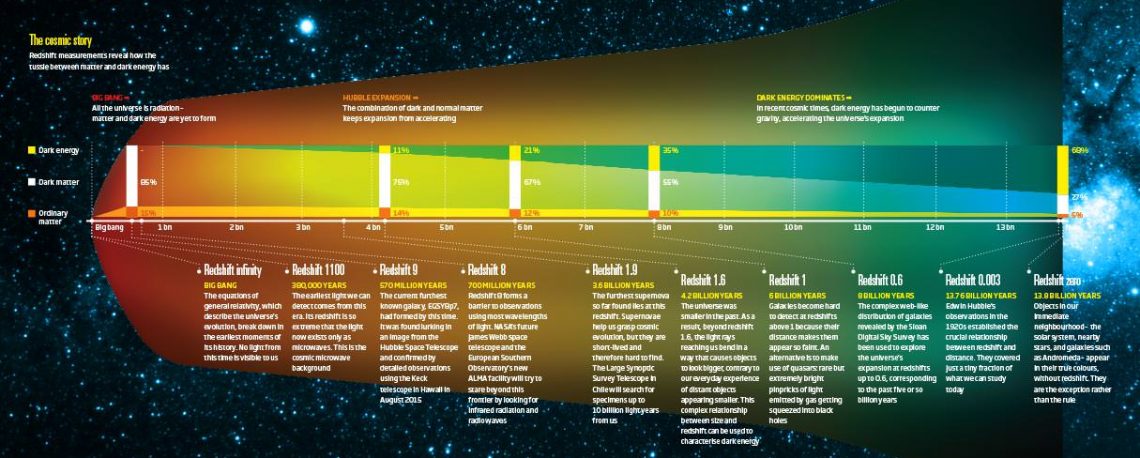Introduction to Cosmological Redshift
Ok, we are all familiar with this situation: you hear an siren on a firetruck, ambulance, or police car and you stop for it to pass. You notice that the sound of the siren changes pitch. Most people can even imitate that sound themselves. Well, that is known as the “Doppler Shift” and has everything to do with the idea that the universe is “supposedly” expanding because of the “Doppler Effect” for light called the “red shift”.
The Doppler effect is named after Christian Doppler, an Austrian physicist, who described this effect in 1842. The Doppler Effect, or Doppler shift, corresponds to a shift in frequency of a wave relative to an observer moving relative to the source of the wave. The effect was originally applied to sound waves but this can be applied to any wave phenomenon, including light. In the domain of sound, when an object is moving toward an observer, the sound it emits will have a higher pitch as heard by the observer, and when an object is moving away from the observer, a lower pitch will be heard. In the domain of light, when an object is moving toward an observer, the light it emits will appear blue-shifted to the observer, but when the object is moving away from the observer, the light will appear red-shifted. Blue shift is analogous to the pitch going up, and red shift is analogous to the pitch going down.
How is red shift determined?
Using experiments here on earth, we discovered that each element in the periodic table emits light at different wavelengths. The wavelength emitted by an element is determined by the excitation states of atoms and manifests as emission lines or absorption lines in a device known as a spectrograph. We can determine which elements are present in an “object” by measuring the position of the spectral lines in the graph. In order to determine if a cosmological object is Doppler shifted, the light from the source is directed to a spectrograph. If the object is red shifted, the expected spectral lines will be shifted to the left (for red shift), or to the right (for blue shift), compared to the spectral lines as seen by a light source here on earth.
Cosmological Red Shift
Through observation, it was found that many objects in the universe, especially galaxies and quasars, have their spectral lines significantly shifted from the expected spectral lines. Furthermore, most of these cosmological objects exhibit a shift in the red direction. In fact, when quasars were first discovered, the spectral line of hydrogen was shifted so much, they didn’t recognize it, and they thought that quasars were made of some exotic material yet to be discovered. Eventually, the hydrogen line was recognized and quasars were reinterpreted as extremely massive objects formed shortly after the “Big Bangâ€.
Using the Doppler interpretation of red shift, it is thought that all distant cosmological objects are moving away from us (and each other). This is known as the Hubble expansion. This was the evidence used to develop the theory commonly known as the Big Bang. It was also discovered, using standard candles, that the more distant objects are also more red shifted than objects closer to earth. Using the Doppler interpretation of red shift, this implies that, not only is the universe expanding, the expansion must be accelerating. This interpretation of cosmological red shift has persisted for many years.
But, is the Doppler explanation of cosmological redshift the only explanation for the shifted spectral lines of elements of the periodic table? The answer to this question is, no. There are some known explanations, and other speculative explanations that could explain this observation.
Gravitational Redshift
Another type of redshift that can be proven via experimentation is known as gravitation redshift, also known as the “Einstein Effectâ€. According to general relativity, gravitational redshift is a result of time dilation which occurs near massive cosmological objects such as black holes. A hydrogen atom, for example, that is in a strong gravitational field, will have a much lower frequency, due to clock retardation (time dilation). Any spectrograph that receives this signal will have a spectral line that is redshifted from the standard hydrogen line. The stronger the gravitation field, the more the line will be shifted.
This effect has has been verified by a group from the Dark Cosmology Center at the University of Copenhagen in 2011. The paper is called, “Gravitational redshift of galaxies in clusters as predicted by general relativityâ€. In this research, data was collected from 8000 galaxy clusters. It was found that the light coming from the cluster centres tended to be more red-shifted compared to the light from the edges of the clusters. Although this effect has been verified, it cannot be the source of cosmological redshift since, if it were, objects that are farther away in time would also have to be much massive than galaxies of our current time and this does not appear to be the case.
Tired Light
The tired light theory proposes an alternate explanation of the red shift to distance relationship that does not require the accelerated expansion of the universe. There are many tired light models out there that use different explanations for why light should behave this way. These models are generally associated with steady state models of the universe as opposed to the expanding universe described by the Big Bang model. The concept was first described in 1929 by a man names Fritx Zwicky who proposed that “photons” emitted by distant objects lose energy over time, through collisions with other particles on their journey through space. Light from the more distant objects would interact with more particles which would explain why more distant objects appear more red shifted.
For example, in this paper, “An Alternative Explanation for Cosmological Redshift“, tired light is thought to be caused by particle interactions creating an overall index of refraction of the universe. The effects are cumulative over long distance resulting in an increase in redshift with distance. In this model, the universe need not be expanding.
The main objection to the tired light theory is that there is no known mechanism for a photon to lose energy without changing some other observable. For example, if the loss of energy is due to the interaction of light with particles in space, the light would be scattered and the sources would appear more blurred then what we observe.
Intrinsic Redshift
Another famous critical thinker and astronomy, Halton Arp made it his lifetime work to study galaxies, quasars and redshift. In his book, “Seeing Red”, he came to the conclusion that objects in space had an “instrinsic” or “built-in” redshift.
Arp’s explanation was that objects such as Quasars or galaxies all had intrinsic redshift due to their chemical makeup and that the redshift changed over time. This flew in the face of mainstream astronomy which said that redshift came from the speed of objects in an expanding universe. The evidence against redshift as a kind of Doppler Effect was the fact that quasars that were coming out of the center of galaxies had different redshifts than from the galaxies and therefore became evidence that redshift was in fact something other than caused by movement.
Halton Arp’s interpretation of cosmological redshift face flew in the face of big bang cosmology and caused him to be ostracized from using the large 200 inch telescope to make further observations. Giving a different explanation for redshift upset too many apple carts in Big Cosmology and instead of looking for truth like Halton Arp, Big Science chose to turn its head on observational fact.
Below is a video from 2014 of a presentation given by Halton Arp showing observational evidence for his controversial interpretation of redshift.
Infinity
Another simple explanation for redshift is the idea that nothing in in the universe can travel forever without any affect. Dr. Glenn Borchardt, known as “Mr. Infinity” and a scientist who argues against the theory of the big bang, states in his numerous books that nothing, including light can travel through space with no effect.
According to Borchardt, space is not empty and as light travels through space, it encounters resistance and therefor, by the time it gets to any observer, there will be a change – and in this case, it is frequency. This means that no matter where you are in Borchardt’s infinite universe, everyone everywhere will see redshift.
Fractal Geometry: an unique explanation for redshift
One of the great questions in modern cosmology today is what is causing the apparent accelerating expansion of the universe. It has been recently discovered this property is not unique to the universe; trees also do it and trees are fractals. Can fractals offer insight to the accelerating expansion a property of the universe and more? Here is a link to an article that explains how fractal geometry can be used to explain the redshift that we currently observe in the universe.
References
Technical Papers & Abstracts (Count: 64)
![]()



